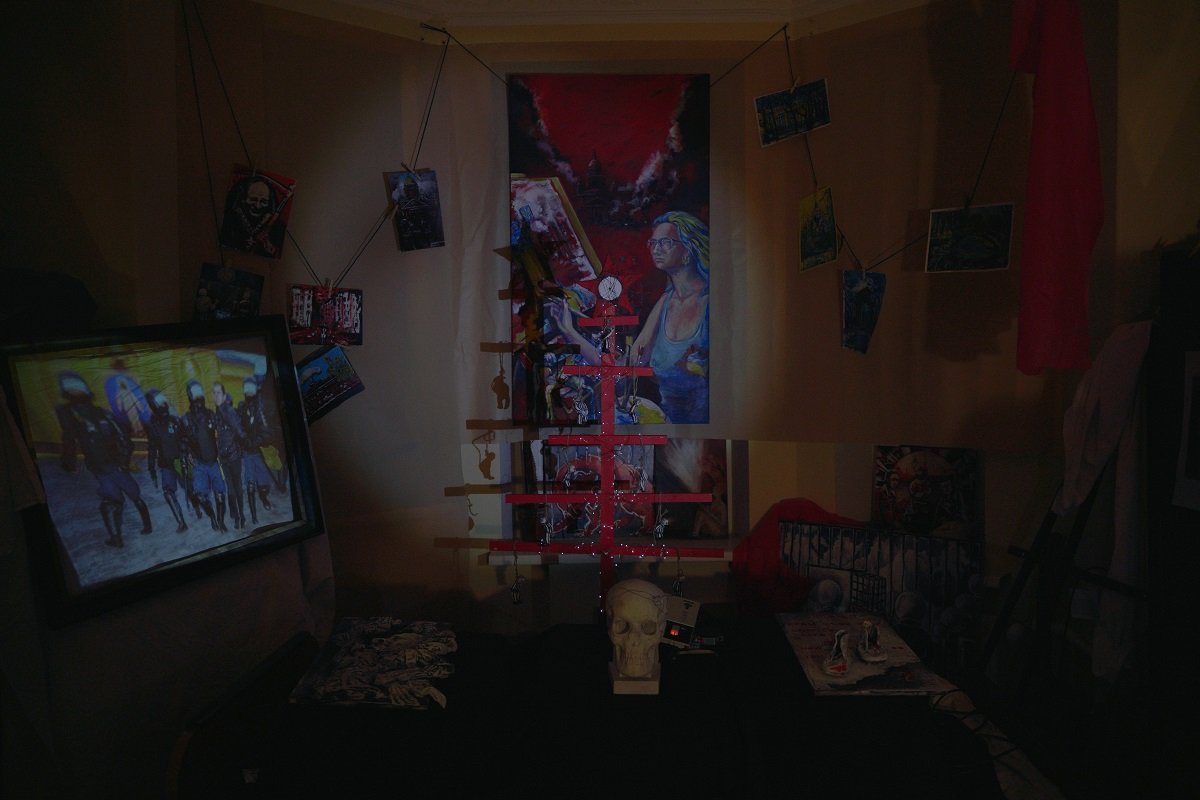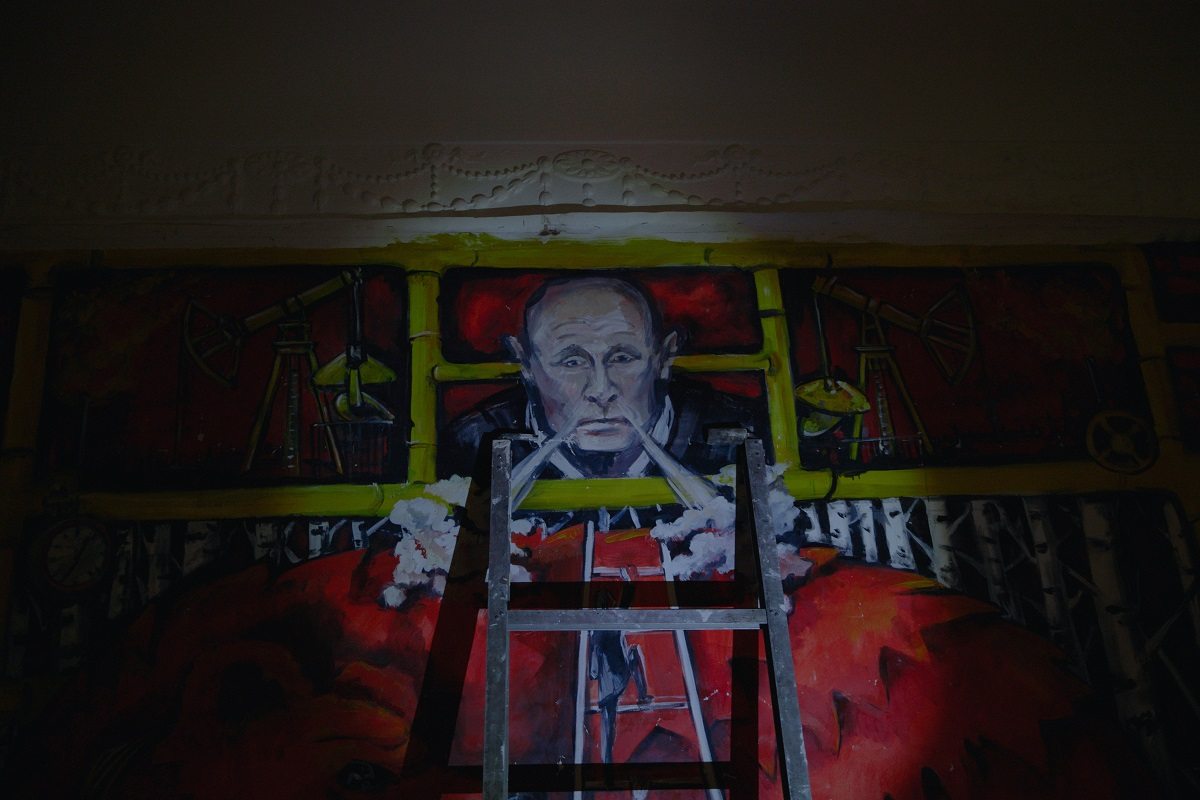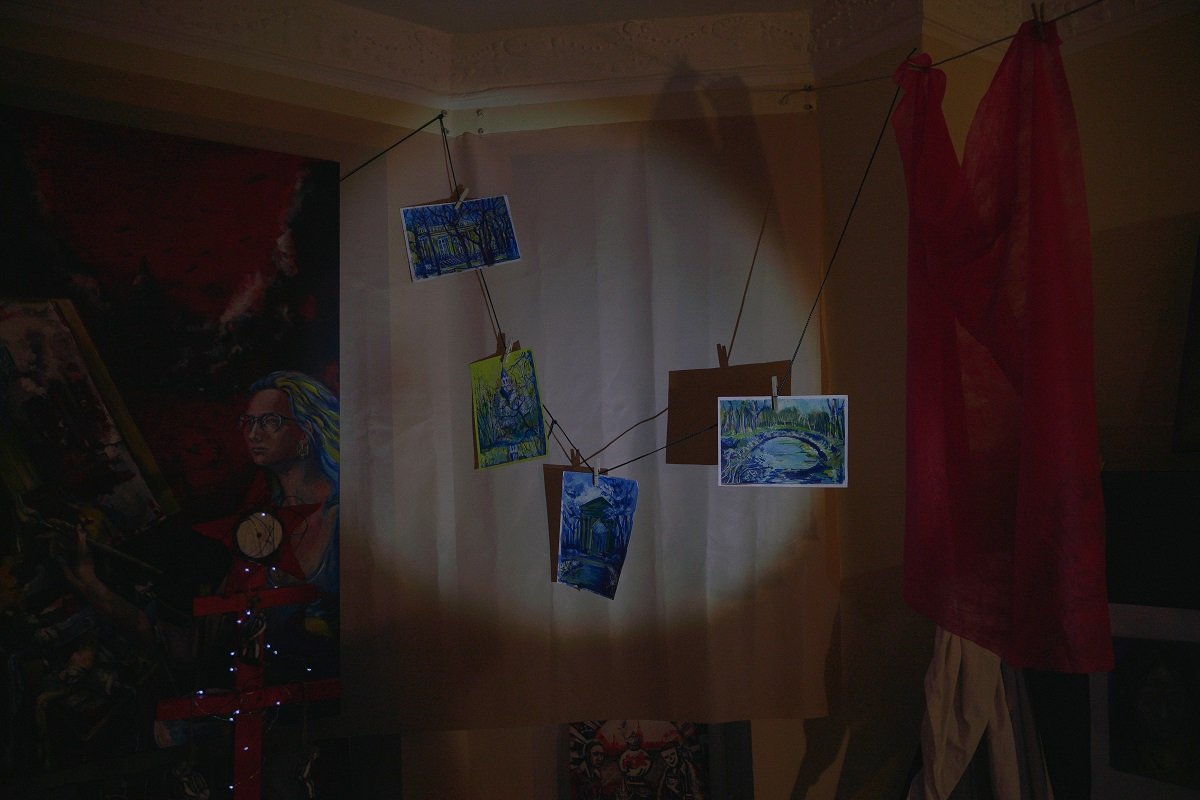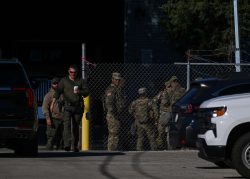
With criticism of the military outlawed in Russia, artists opposed to the war in Ukraine put together an underground exhibition in St. Petersburg.
13:50 JST, March 10, 2023
ST. PETERSBURG – The meeting place to visit the exhibition is an anonymous bus stop opposite a snowy park in the northern Russian city of St. Petersburg at nightfall. There are no tickets and no website promoting the show – a secret, underground display of antiwar protest art.
A few people gather, eyes flicking from one face to another. A thin artist with skinny black pants, a dark puffer jacket and a black shawl covering her hair strides up, nods subtly and tells us to turn off our cellphones to avoid tracking by security agents.
Amid President Vladimir Putin’s crackdown on human rights activists, lawyers and journalists, Russian antiwar artists are going underground, reprising the covert exhibitions of Soviet times, meeting in secret and passing on details by word of mouth.
For some, going underground is liberating. For others it is a painful choice, as the regime stifles public dissent and portrays the war as an existential battle for Russia’s survival that only traitors oppose. In Russia, criticizing the military or even publicizing Russian military abuses in Ukraine is a crime.
We head away from the bus stop in a straggly group, walking a big circle around half a block, ducking through a courtyard with snowy puddles, past a cafe and finally through a door and up many flights of narrow steps. We are warned not to speak to anyone we pass on the stairs.
Inside the narrow apartment hallway, coats and shoes are piled high. A group of activists and friends congregate in the kitchen, drinking tea at a table crammed with plates of cakes, cookies, marshmallows and candies.
The lights are dimmed, as the artist who met us at the bus stop acts as a guide. It is the second exhibition here, organized by artists who have been arrested for protesting the war or had their works seized by police in exhibitions since the invasion.
“We were afraid if we had an exhibition the police would come and arrest us, so we decided to be underground. It’s like turning the lock back to the Soviet years,” said the artist, leading the way into a room with portraits of arrested activists, political prisoners and scenes of Russian riot police dragging protesters away. There are grim portraits of Putin, portrayed as a demonic figure surrounded by chaos and war.
The works are not refined, consisting largely of visceral protest art in vivid colors, including some of the antiwar banners people held up at protest rallies. The small lavatory, with its dank odor, is decked out with bloody images of Putin and Kremlin spokesman Dmitry Peskov.
“The art here is by people who were arrested for protests; they’re people we know,” the artist said. “You just come and put up your work. It’s all free here. There’s no censorship.”
And yet the exhibition itself is a product of fear. Even as they enjoy their secret freedom, the artists know that going underground suits the regime.
“This process of fear, this Russian complex of being a small person, is a state of mind,” the artist said. “We grew up with it and we’re always afraid. You’re a tiny person opposed to a huge country and it treats you as a tool to serve its purpose.” She added: “You’re supposed to follow the rules and keep quiet and if you’re different, they’ll crush you.”
Outside this underground art show, Russia’s wider art world has come under tightening state control.
Last month in Moscow, Zelfira Tregulova, the director of the renowned State Tretyakov Gallery, was replaced by Yelena Pronicheva, daughter of a former senior official of the Federal Security Service (FSB), after the Culture Ministry demanded that the museum promote Russian moral and spiritual values.
In January, a painting by well-known contemporary St. Petersburg artist Dmitry Shagin was removed from Moscow’s All-Russian Decorative Art Museum because it depicted figures with a banner containing “political overtones.”
The offending slogan on the banner, “The Mitki don’t want to defeat anybody,” is a reference to the Mitki, a beloved Soviet hippie art collective that Shagin founded in the 1980s, when the group’s vibrant, colorful works and playful themes were at odds with the dour Soviet era. At the time, the Soviet Union was fighting in Afghanistan.

A secret exhibition of antiwar art in St. Petersburg included grim portraits of Russian President Vladimir Putin.
Shagin said the slogan dated back to 1984 and merely summarized the group’s peaceful philosophy. “The main idea of the Mitki art is kindness,” he said. “And, you know, we tried to bring people joy, and our works are very humanist and peaceful and positive.”
Shagin grew up hanging around secret art exhibitions in private apartments. His father, Vladimir Shagin, was an underground nonconformist artist who was jailed for six years for his art in Soviet times.
After graduating from art school, Dmitry Shagin took up art in the late 1970s, but also got a job shoveling coal in a boiler room – like many nonconformist artists – because between intensive shifts there was time off to paint. In Putin’s wartime Russia, where denunciations are rife, even venerated artists are now vulnerable.
“For artists like us, the atmosphere is not great because we see censorship is returning,” Shagin said. “I started out as an artist in the late 1970s and the last time a painting of mine was banned was in 1986.” He added: “The atmosphere is strange. I don’t know whether they will ban the Mitki or let us exist.”
Yelena Osipova, a 77-year-old St. Petersburg artist and high-profile peace activist, is frequently led away by police for staging protest pickets. Last month, police raided an exhibition of her antiwar posters and seized them. She said she was dismayed by Russians’ indifference to the war, and the shrinking space for dissent and artistic expression.
“A lot of artistic people have left the country because it is not possible to create art here because of censorship,” Osipova said. “There is much less freedom now. Exhibitions are going deep underground. No one talks about them openly, but they are happening all the time.” Osipova said she does not fear arrest and exhibits her work openly.
But the vacant St. Petersburg apartment of a Russian woman who moved to the United States is a cozy haven for underground artists and activists. The emigrant told the organizers to use it whenever they want, but to leave the curtains closed and keep a hush at night.
Our guide points to her own work on one wall, scenes in blue and yellow acrylic, the colors of Ukraine. When painting scenes outdoors she uses only those two colors, in what she calls “a quiet protest.”
Another artist, a mother of two young children who was seated at the kitchen table in the apartment, said seeing videos and images of civilians killed by Russian forces in Ukraine’s Bucha was “like an earthquake. I felt I needed to get it out of me. I could not keep silent.”
She was arrested at a demonstration last year, but later stopped protesting for fear authorities could jail her and take away her children – an increasingly common practice. Instead, she poured her feelings into sketches of a weeping mother of God icon watching a flying missile.
“I started to draw, just so as not to be silent,” she said. “I felt as if words were not enough to describe what I was feeling.”
One artist, Nikolai, displayed a broken red brick on a black base, resembling a ruined building, with the title “Mariupol” – the Russian-occupied city in southeast Ukraine that was nearly destroyed by bombing. Some of Nikolai’s works have been seized by police at exhibitions.
“We’re in a situation where the government calls us criminals because we’re against the war,” he said.
The artist guiding visitors around the exhibition said it was a source of mutual support and comfort for artists. But she sees hard times ahead for Russia. “Sometimes you feel really low, because not many people see what you’re doing and there’s no way to influence what is going on,” she said. “I feel that the protests and drawings are not enough to change things. I don’t believe in the salvation of the country.”
But Shagin, a lifelong optimist, says artists, like his father in the repressive Soviet era of the 1950s and 1960s, cannot be trampled. “Art is free,” he said. “It cannot be controlled from outside, and it will always be free.”

A view of the St. Petersburg exhibition.
"News Services" POPULAR ARTICLE
-

American Playwright Jeremy O. Harris Arrested in Japan on Alleged Drug Smuggling
-

Japan’s Nikkei Stock Average as JGB Yields, Yen Rise on Rate-Hike Bets
-

Japan’s Nikkei Stock Average Licks Wounds after Selloff Sparked by BOJ Hike Bets (UPDATE 1)
-

Japan’s Nikkei Stock Average Buoyed by Stable Yen; SoftBank’s Slide Caps Gains (UPDATE 1)
-

Japanese Bond Yields Zoom, Stocks Slide as Rate Hike Looms
JN ACCESS RANKING
-

Tokyo Economic Security Forum to Hold Inaugural Meeting Amid Tense Global Environment
-

Keidanren Chairman Yoshinobu Tsutsui Visits Kashiwazaki-Kariwa Nuclear Power Plant; Inspects New Emergency Safety System
-

Imports of Rare Earths from China Facing Delays, May Be Caused by Deterioration of Japan-China Relations
-

University of Tokyo Professor Discusses Japanese Economic Security in Interview Ahead of Forum
-

Japan Pulls out of Vietnam Nuclear Project, Complicating Hanoi’s Power Plans
























